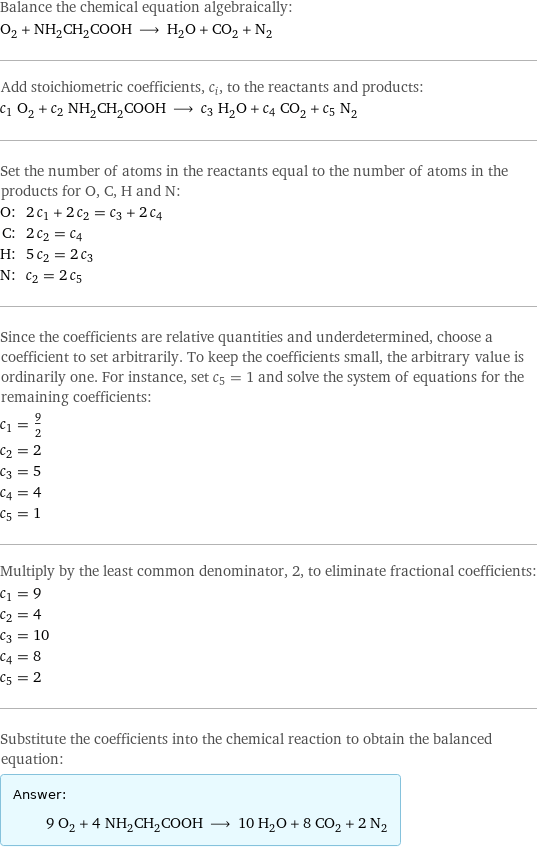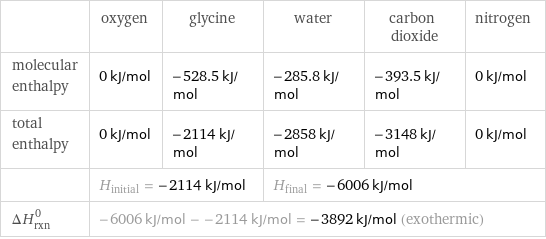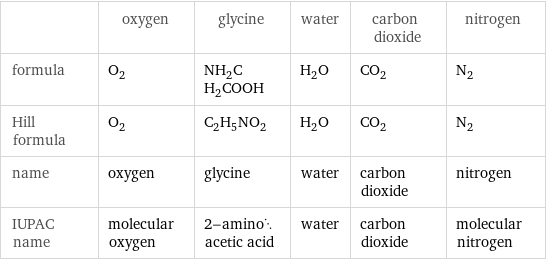Input interpretation

O_2 oxygen + NH_2CH_2COOH glycine ⟶ H_2O water + CO_2 carbon dioxide + N_2 nitrogen
Balanced equation

Balance the chemical equation algebraically: O_2 + NH_2CH_2COOH ⟶ H_2O + CO_2 + N_2 Add stoichiometric coefficients, c_i, to the reactants and products: c_1 O_2 + c_2 NH_2CH_2COOH ⟶ c_3 H_2O + c_4 CO_2 + c_5 N_2 Set the number of atoms in the reactants equal to the number of atoms in the products for O, C, H and N: O: | 2 c_1 + 2 c_2 = c_3 + 2 c_4 C: | 2 c_2 = c_4 H: | 5 c_2 = 2 c_3 N: | c_2 = 2 c_5 Since the coefficients are relative quantities and underdetermined, choose a coefficient to set arbitrarily. To keep the coefficients small, the arbitrary value is ordinarily one. For instance, set c_5 = 1 and solve the system of equations for the remaining coefficients: c_1 = 9/2 c_2 = 2 c_3 = 5 c_4 = 4 c_5 = 1 Multiply by the least common denominator, 2, to eliminate fractional coefficients: c_1 = 9 c_2 = 4 c_3 = 10 c_4 = 8 c_5 = 2 Substitute the coefficients into the chemical reaction to obtain the balanced equation: Answer: | | 9 O_2 + 4 NH_2CH_2COOH ⟶ 10 H_2O + 8 CO_2 + 2 N_2
Structures

+ ⟶ + +
Names

oxygen + glycine ⟶ water + carbon dioxide + nitrogen
Reaction thermodynamics
Enthalpy

| oxygen | glycine | water | carbon dioxide | nitrogen molecular enthalpy | 0 kJ/mol | -528.5 kJ/mol | -285.8 kJ/mol | -393.5 kJ/mol | 0 kJ/mol total enthalpy | 0 kJ/mol | -2114 kJ/mol | -2858 kJ/mol | -3148 kJ/mol | 0 kJ/mol | H_initial = -2114 kJ/mol | | H_final = -6006 kJ/mol | | ΔH_rxn^0 | -6006 kJ/mol - -2114 kJ/mol = -3892 kJ/mol (exothermic) | | | |
Equilibrium constant
![Construct the equilibrium constant, K, expression for: O_2 + NH_2CH_2COOH ⟶ H_2O + CO_2 + N_2 Plan: • Balance the chemical equation. • Determine the stoichiometric numbers. • Assemble the activity expression for each chemical species. • Use the activity expressions to build the equilibrium constant expression. Write the balanced chemical equation: 9 O_2 + 4 NH_2CH_2COOH ⟶ 10 H_2O + 8 CO_2 + 2 N_2 Assign stoichiometric numbers, ν_i, using the stoichiometric coefficients, c_i, from the balanced chemical equation in the following manner: ν_i = -c_i for reactants and ν_i = c_i for products: chemical species | c_i | ν_i O_2 | 9 | -9 NH_2CH_2COOH | 4 | -4 H_2O | 10 | 10 CO_2 | 8 | 8 N_2 | 2 | 2 Assemble the activity expressions accounting for the state of matter and ν_i: chemical species | c_i | ν_i | activity expression O_2 | 9 | -9 | ([O2])^(-9) NH_2CH_2COOH | 4 | -4 | ([NH2CH2COOH])^(-4) H_2O | 10 | 10 | ([H2O])^10 CO_2 | 8 | 8 | ([CO2])^8 N_2 | 2 | 2 | ([N2])^2 The equilibrium constant symbol in the concentration basis is: K_c Mulitply the activity expressions to arrive at the K_c expression: Answer: | | K_c = ([O2])^(-9) ([NH2CH2COOH])^(-4) ([H2O])^10 ([CO2])^8 ([N2])^2 = (([H2O])^10 ([CO2])^8 ([N2])^2)/(([O2])^9 ([NH2CH2COOH])^4)](../image_source/7f8778607120177f413e88b04da5846a.png)
Construct the equilibrium constant, K, expression for: O_2 + NH_2CH_2COOH ⟶ H_2O + CO_2 + N_2 Plan: • Balance the chemical equation. • Determine the stoichiometric numbers. • Assemble the activity expression for each chemical species. • Use the activity expressions to build the equilibrium constant expression. Write the balanced chemical equation: 9 O_2 + 4 NH_2CH_2COOH ⟶ 10 H_2O + 8 CO_2 + 2 N_2 Assign stoichiometric numbers, ν_i, using the stoichiometric coefficients, c_i, from the balanced chemical equation in the following manner: ν_i = -c_i for reactants and ν_i = c_i for products: chemical species | c_i | ν_i O_2 | 9 | -9 NH_2CH_2COOH | 4 | -4 H_2O | 10 | 10 CO_2 | 8 | 8 N_2 | 2 | 2 Assemble the activity expressions accounting for the state of matter and ν_i: chemical species | c_i | ν_i | activity expression O_2 | 9 | -9 | ([O2])^(-9) NH_2CH_2COOH | 4 | -4 | ([NH2CH2COOH])^(-4) H_2O | 10 | 10 | ([H2O])^10 CO_2 | 8 | 8 | ([CO2])^8 N_2 | 2 | 2 | ([N2])^2 The equilibrium constant symbol in the concentration basis is: K_c Mulitply the activity expressions to arrive at the K_c expression: Answer: | | K_c = ([O2])^(-9) ([NH2CH2COOH])^(-4) ([H2O])^10 ([CO2])^8 ([N2])^2 = (([H2O])^10 ([CO2])^8 ([N2])^2)/(([O2])^9 ([NH2CH2COOH])^4)
Rate of reaction
![Construct the rate of reaction expression for: O_2 + NH_2CH_2COOH ⟶ H_2O + CO_2 + N_2 Plan: • Balance the chemical equation. • Determine the stoichiometric numbers. • Assemble the rate term for each chemical species. • Write the rate of reaction expression. Write the balanced chemical equation: 9 O_2 + 4 NH_2CH_2COOH ⟶ 10 H_2O + 8 CO_2 + 2 N_2 Assign stoichiometric numbers, ν_i, using the stoichiometric coefficients, c_i, from the balanced chemical equation in the following manner: ν_i = -c_i for reactants and ν_i = c_i for products: chemical species | c_i | ν_i O_2 | 9 | -9 NH_2CH_2COOH | 4 | -4 H_2O | 10 | 10 CO_2 | 8 | 8 N_2 | 2 | 2 The rate term for each chemical species, B_i, is 1/ν_i(Δ[B_i])/(Δt) where [B_i] is the amount concentration and t is time: chemical species | c_i | ν_i | rate term O_2 | 9 | -9 | -1/9 (Δ[O2])/(Δt) NH_2CH_2COOH | 4 | -4 | -1/4 (Δ[NH2CH2COOH])/(Δt) H_2O | 10 | 10 | 1/10 (Δ[H2O])/(Δt) CO_2 | 8 | 8 | 1/8 (Δ[CO2])/(Δt) N_2 | 2 | 2 | 1/2 (Δ[N2])/(Δt) (for infinitesimal rate of change, replace Δ with d) Set the rate terms equal to each other to arrive at the rate expression: Answer: | | rate = -1/9 (Δ[O2])/(Δt) = -1/4 (Δ[NH2CH2COOH])/(Δt) = 1/10 (Δ[H2O])/(Δt) = 1/8 (Δ[CO2])/(Δt) = 1/2 (Δ[N2])/(Δt) (assuming constant volume and no accumulation of intermediates or side products)](../image_source/03e2f88d4eb61ffc0e3c9ed650a0f260.png)
Construct the rate of reaction expression for: O_2 + NH_2CH_2COOH ⟶ H_2O + CO_2 + N_2 Plan: • Balance the chemical equation. • Determine the stoichiometric numbers. • Assemble the rate term for each chemical species. • Write the rate of reaction expression. Write the balanced chemical equation: 9 O_2 + 4 NH_2CH_2COOH ⟶ 10 H_2O + 8 CO_2 + 2 N_2 Assign stoichiometric numbers, ν_i, using the stoichiometric coefficients, c_i, from the balanced chemical equation in the following manner: ν_i = -c_i for reactants and ν_i = c_i for products: chemical species | c_i | ν_i O_2 | 9 | -9 NH_2CH_2COOH | 4 | -4 H_2O | 10 | 10 CO_2 | 8 | 8 N_2 | 2 | 2 The rate term for each chemical species, B_i, is 1/ν_i(Δ[B_i])/(Δt) where [B_i] is the amount concentration and t is time: chemical species | c_i | ν_i | rate term O_2 | 9 | -9 | -1/9 (Δ[O2])/(Δt) NH_2CH_2COOH | 4 | -4 | -1/4 (Δ[NH2CH2COOH])/(Δt) H_2O | 10 | 10 | 1/10 (Δ[H2O])/(Δt) CO_2 | 8 | 8 | 1/8 (Δ[CO2])/(Δt) N_2 | 2 | 2 | 1/2 (Δ[N2])/(Δt) (for infinitesimal rate of change, replace Δ with d) Set the rate terms equal to each other to arrive at the rate expression: Answer: | | rate = -1/9 (Δ[O2])/(Δt) = -1/4 (Δ[NH2CH2COOH])/(Δt) = 1/10 (Δ[H2O])/(Δt) = 1/8 (Δ[CO2])/(Δt) = 1/2 (Δ[N2])/(Δt) (assuming constant volume and no accumulation of intermediates or side products)
Chemical names and formulas

| oxygen | glycine | water | carbon dioxide | nitrogen formula | O_2 | NH_2CH_2COOH | H_2O | CO_2 | N_2 Hill formula | O_2 | C_2H_5NO_2 | H_2O | CO_2 | N_2 name | oxygen | glycine | water | carbon dioxide | nitrogen IUPAC name | molecular oxygen | 2-aminoacetic acid | water | carbon dioxide | molecular nitrogen